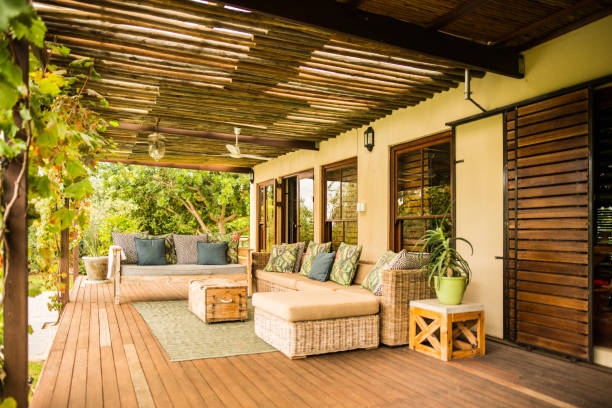California’s diverse landscapes and climates offer a unique challenge for homeowners looking to create functional and beautiful outdoor living spaces. From coastal breezes to desert heat, each region demands tailored design strategies to ensure comfort, sustainability, and longevity. This guide explores how to customize outdoor spaces for California’s varied microclimates, offering insights on design, materials, and installation to help you make the most of your outdoor living experience. Whether you’re working with local landscapers in Santa Clara county or just browsing for inspirations online, understanding these principles will help you create an ideal outdoor retreat.
Contents
Understanding California’s Microclimates
California’s microclimates range from coastal and inland areas to desert and mountainous regions. Each climate brings its own set of challenges and opportunities for outdoor design.
- Coastal Climate: Characterized by mild temperatures, high humidity, and salty air, coastal areas require materials that can withstand corrosion and wind.
- Inland/Valley Climate: Known for hot summers and cool winters, inland regions need solutions for sun exposure and water conservation.
- Desert Climate: Featuring extreme temperatures and low humidity, desert areas demand heat-tolerant and water-efficient designs.
- Mountain Climate: With cooler temperatures and snow, mountainous regions need durable materials and solutions for frost and snow loads.
Design Strategies for Each Microclimate
Designing outdoor spaces effectively requires understanding the specific needs of each microclimate. By tailoring your approach to the unique climate conditions, you can create a space that is not only visually appealing but also functional and resilient. Here’s how to approach outdoor design for California’s diverse microclimates, ensuring that each space is optimized for its environment.
Coastal Microclimate
Designing for coastal climates involves choosing materials that resist corrosion and withstand salty air. Weather-resistant furniture, such as marine-grade stainless steel and composite decking, helps maintain the longevity of your outdoor space. Incorporating windbreaks like hedges and trellises can provide protection against strong coastal winds. Selecting salt-tolerant plants such as succulents and lavender ensures your garden thrives in the humid, salty environment.
Inland/Valley Microclimate
In inland and valley areas, managing the intense summer heat and cooler winter temperatures is essential. Shade solutions, like pergolas and shade sails, offer relief from the sun and help keep outdoor areas cooler. Efficient water management through drip irrigation systems and drought-tolerant landscaping techniques can address the challenges of water conservation. Light-colored surfaces and cooling systems like misting fans help manage heat effectively.
Desert Microclimate
Desert climates require thoughtful design to handle extreme temperatures and low humidity. Using heat-resistant and UV-resistant materials, such as stone or concrete, ensures durability and comfort. Implementing water-saving measures like drip irrigation and selecting low-water-use plants, such as agave and yucca, helps conserve water in arid conditions. Retractable awnings and sunshades provide necessary relief from the harsh sun, while fire pits offer warmth during cooler evenings.
Mountain Microclimate
In mountainous areas, the outdoor space must be built to endure cooler temperatures and snow. Durable, weather-resistant furniture and structures that can handle snow loads are essential. Adding heating features like outdoor fireplaces and hot tubs provides comfort during colder months. Frost-resistant plants and proper drainage systems are crucial for maintaining a functional and beautiful outdoor area despite the challenges of snow and frost.
Installation Tips for Outdoor Features in Different Microclimates
Proper installation is crucial for ensuring that your outdoor features are both functional and durable in California’s diverse climates. By tailoring your installation approach to the specific conditions of your microclimate, you can enhance the longevity and comfort of your outdoor space. Partnerin
Pre-Installation Considerations
- Assess local climate conditions to choose appropriate materials and design features.
- Consult with experienced outdoor living contractors in the Bay Area or designers from Sequoia Outdoor to ensure the design meets local requirements and climate needs.
Coastal Installation
- Furniture and Fixtures: Use corrosion-resistant fasteners and secure fixtures to handle salty air and strong winds.
- Decking and Flooring: Opt for raised decking and composite materials to prevent warping from moisture.
Inland/Valley Installation
- Shading Structures: Install retractable awnings or pergolas to provide flexible shade solutions.
- Irrigation Systems: Set up efficient drip irrigation and smart controllers to manage water usage effectively.
Desert Installation
- Heat-Resistant Structures: Choose materials that can handle extreme heat and UV exposure, and ensure they are anchored securely.
- Water Conservation: Implement rainwater harvesting systems and low-water-use landscaping features.
Mountain Installation
- Snow Load Preparation: Build structures with the capability to bear snow loads and ensure proper drainage to avoid water damage from melting snow.
- Heating Features: Install outdoor heaters and fire pits with adequate clearance to provide warmth during colder weather.
With thoughtful planning and expert guidance, your outdoor area can become a comfortable and inviting retreat, regardless of California’s varied weather conditions.

